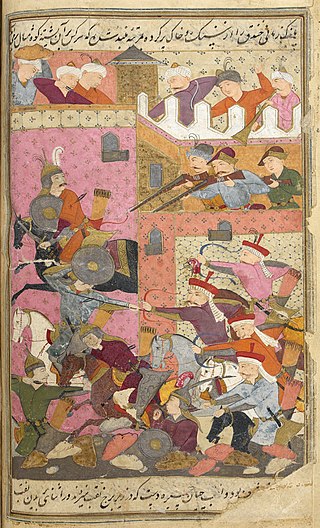Related Research Articles
Uzun Hasan or Uzun Hassan was a ruler of the Turkoman Aq Qoyunlu state and is generally considered to be its strongest ruler. Hasan ruled between 1452 and 1478, and would preside over the confederation's territorial apex when it included parts or all of present-day Iraq, Turkey, Azerbaijan, Iran, Transcaucasia and Syria.
Uthman Beg or Osman Beg was a late 14th and early 15th-century leader of the Turkoman tribal federation of Aq Qoyunlu in what is now eastern Turkey, Iran, Azerbaijan and Iraq.

Khalilullah I, also known as Sultan-Khalil (سلطان-خلیل), was the Shirvanshah from 1418 to 1465. He was the son and successor of Ibrahim I. He was succeeded by his son Farrukh Yasar.

The Aq Qoyunlu or the White Sheep Turkomans was a culturally Persianate, Sunni Turkoman tribal confederation. Founded in the Diyarbakir region by Qara Yuluk Uthman Beg, they ruled parts of present-day eastern Turkey from 1378 to 1503, and in their last decades also ruled Armenia, Azerbaijan, much of Iran, Iraq, and Oman where the ruler of Hormuz recognised Aq Qoyunlu suzerainty. The Aq Qoyunlu empire reached its zenith under Uzun Hasan.

Jalal al-Din Davani, also known as Allama Davani, was a theologian, philosopher, jurist, and poet, who is considered to have been one of the leading scholars in late 15th-century Iran.

Yaqub b. Uzun Hasan, commonly known as Sultan Ya'qub was the ruler of the Aq Qoyunlu from 1478 until his death on 24 December 1490. A son of Uzun Hasan, he became the ruler of the dynasty after the death of his brother Sultan Khalil. The borders of Aq Qoyunlu dynasty remained stable during his reign. In his book Alam-Aray-i Amini, Fazlallah Khunji Isfahani praised him as a decent successor of Uzun Hasan. Ya'qub received praise from other historians for supporting poets and scientists.
Mawsillu was a Turcoman tribe active in Aq Qoyunlu and the Safavid Empire.
Qazi Isa Savaji was a Persian bureaucrat from the Savaji family, who was among the leading figures during the reign of the Aq Qoyunlu rulers Uzun Hasan and Ya'qub Beg.
Jalal ad-Din Ali ibn Qara Yoluq Osman, or Ali Beg was the sixth bey of the Turkoman tribal federation of the Aq Qoyunlu from 1435 to 1438.
Fakhr al-Din Qutlugh-bey was the second Aq Qoyunlu bey, ruling from 1362-1389. His full name was Haji Fakhr al-Din Kutlug ibn Tur Ali-bey.
Ahmad ibn Kutlug, was the third bey of the Aq Qoyunlu confederation (1389-1403).
Sharaf al-Din Shah-Mahmud Jan Daylami Qazvini, better known as Mahmud Jan Daylami was an Iranian bureaucrat from the Daylami family, who occupied high offices under the Aq Qoyunlu and the Safavids.
Sufi Khalil Beg Mawsilu was a Turkoman military officer from the Mawsillu clan, who served the Aq Qoyunlu. He was one of the leading figures during the reign of Sultan Ya'qub Beg, and played a pivotal role in the succession struggle that took place after the latter's death. He put Ya'qub's eldest son Baysunghur on the throne, ruling as the virtual ruler of the realm until he was defeated and killed by his rival, Sulayman Beg Bijan.
The Miranshahi were a collateral branch of the Aq Qoyunlu clan that was founded as a result of the union between Sidi-Ahmad ibn Miranshah Timuri and Uzun Hasan's daughter Ruqaya-Sultan.

Baysunghur was the ruler of the Aq Qoyunlu from 1490 to 1493. He was the son and successor of Ya'qub Beg. He had little power during his short reign, serving as a figurehead, while real power was in possession of his tutor and commander Sufi Khalil Beg Mawsilu in 1490–1492, and then under another commander, Sulayman Beg Bijan in 1492–1493. Baysunghur was killed in 1493 by his cousin Rustam Beg, who succeeded him.

Alvand Mirza was a Aq Qoyunlu prince, who was a contender for the throne between 1497 and 1504/5.

Sultan Murad was the last sultan of the Aq Qoyunlu from 1497 to 1508. After losing his kingdom to the Safavid Shah Ismail I, he fled to Diyar Bakr, where he was eventually killed by Shah Ismail's Qizilbash soldiers at the end of 1514.
The Battle of Urfa is a battle that took place between Aq Qoyunlu and the Mamluk Sultanate in August 1480 at Urfa in Diyar Bakr. The reason was the invasion of the Mamluks into the territory of Aq Qoyunlu to capture Urfa. During the battle, the troops of Aq Qoyunlu inflicted a crushing defeat on the Mamluks.

The Capture of Harput occurred in 1465 when Uzun Hasan attacked the territories of Melik Arslan and captured Harput.
References
- ↑ Woods 1999, p. 155.